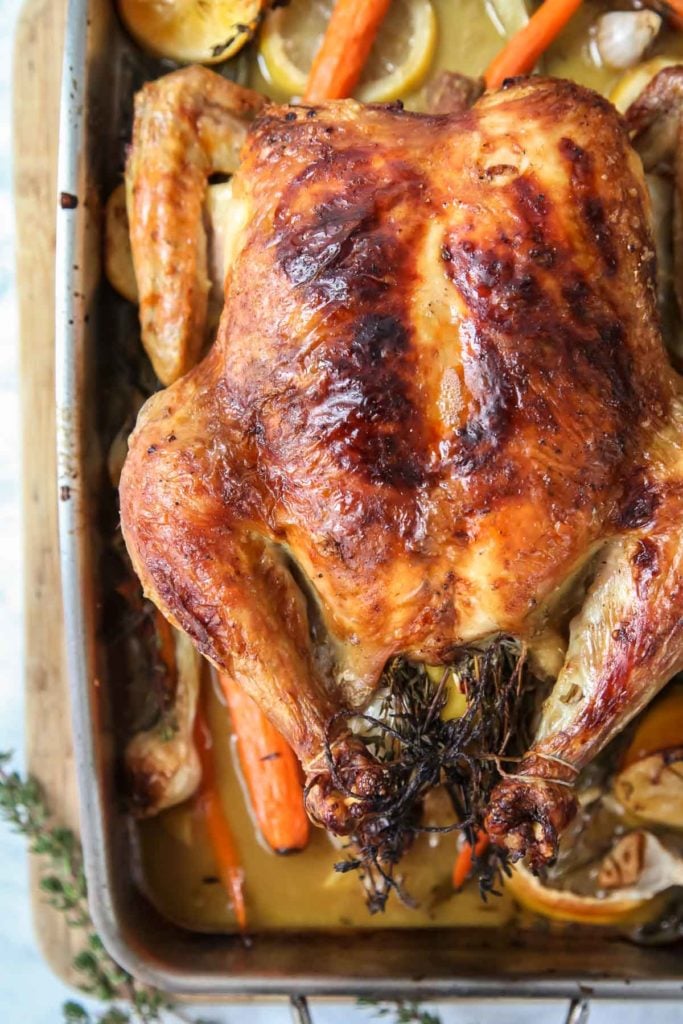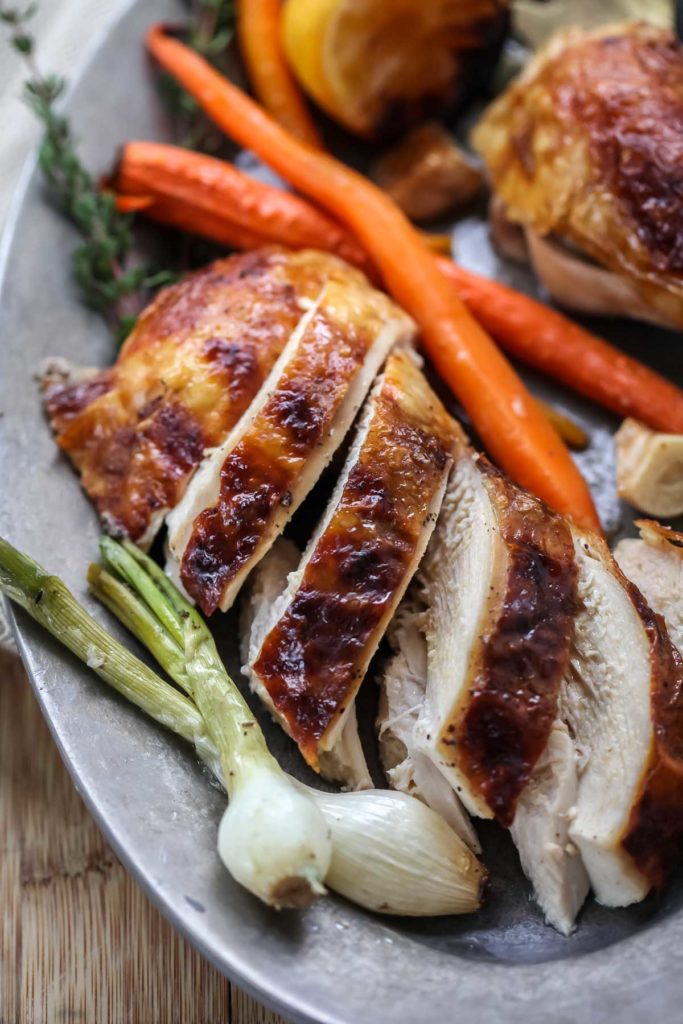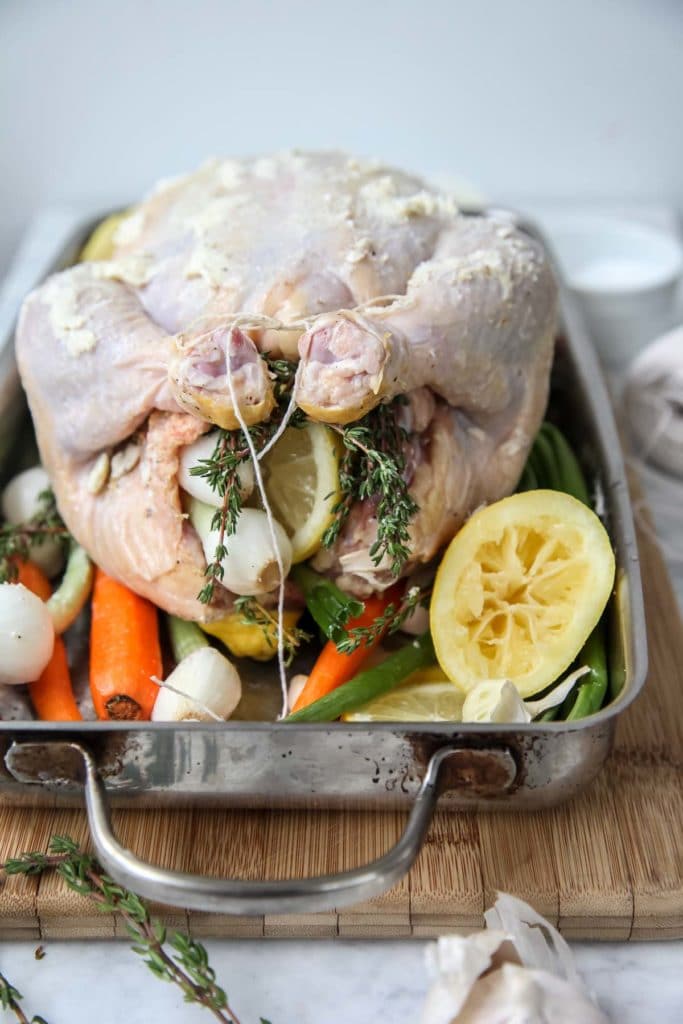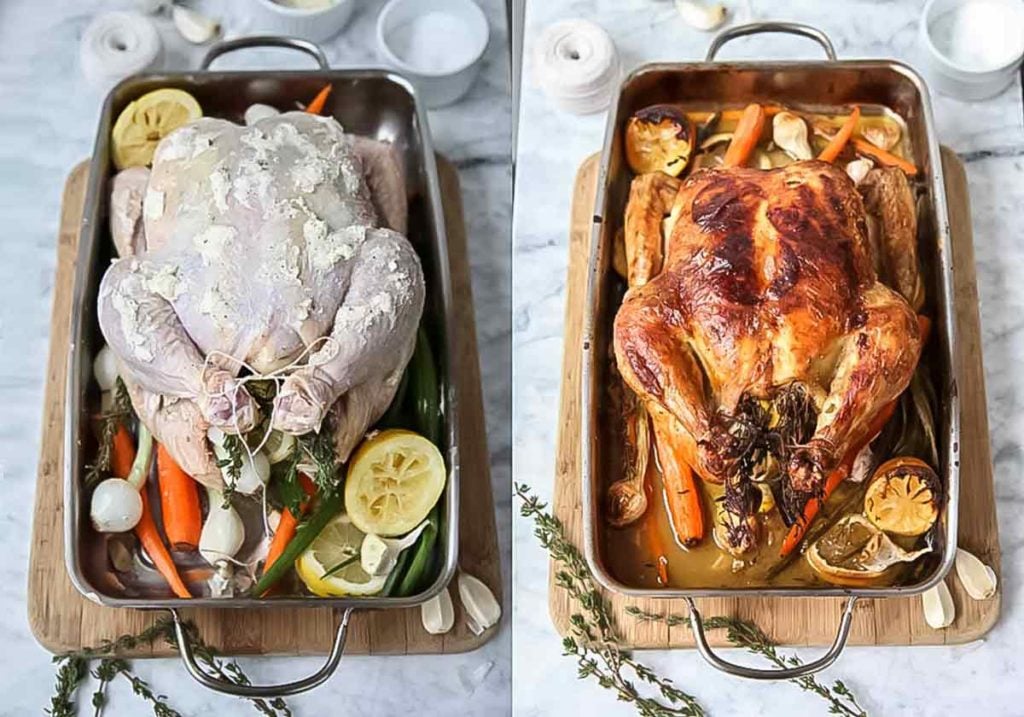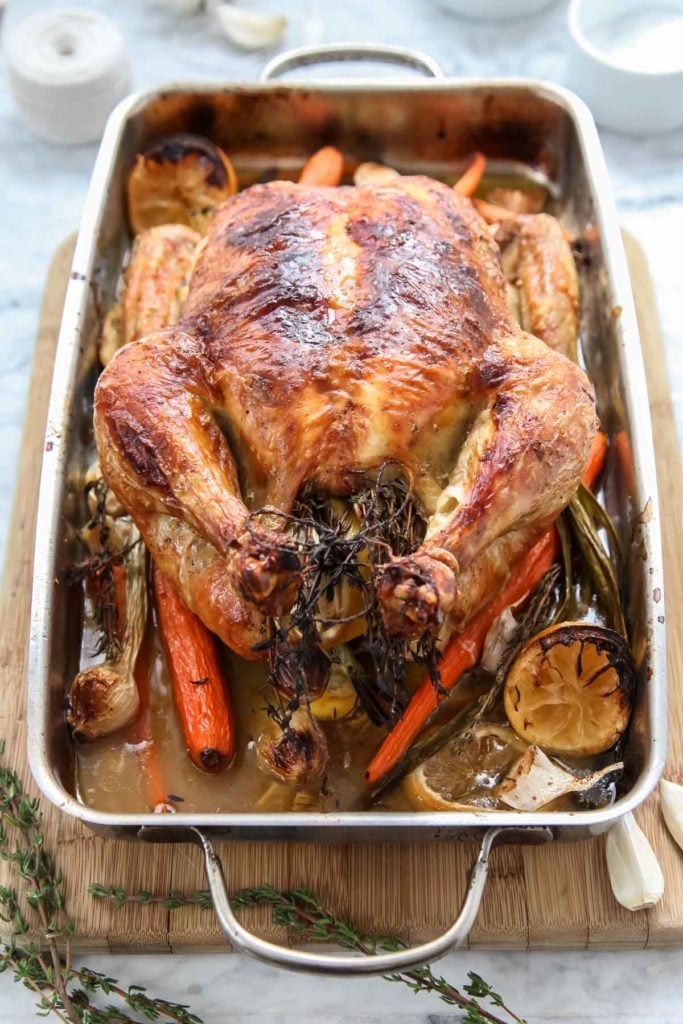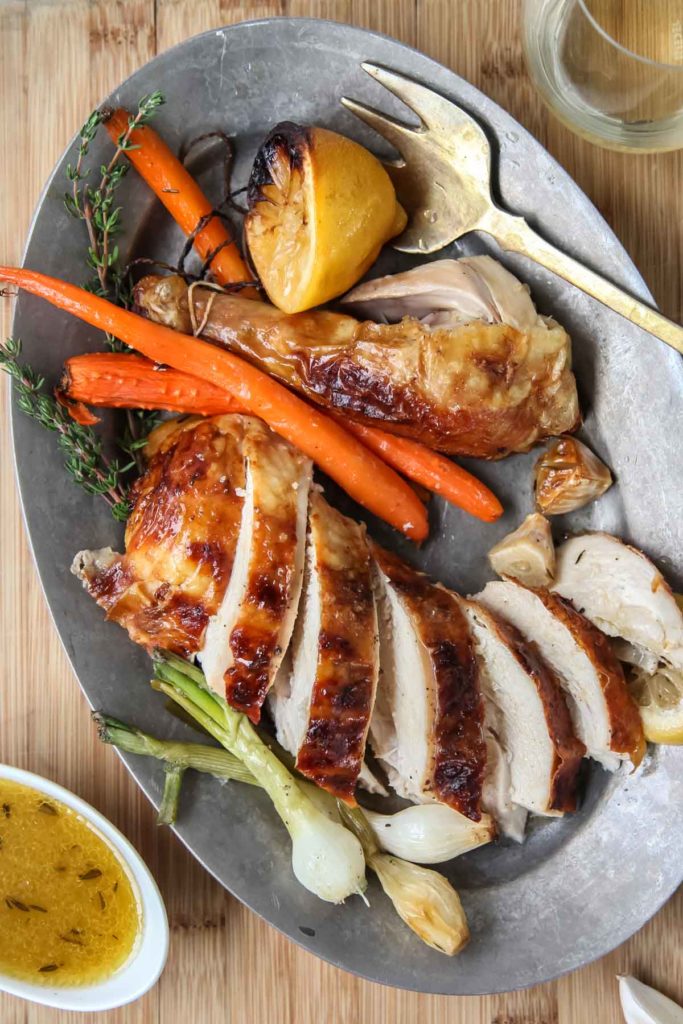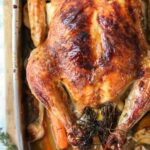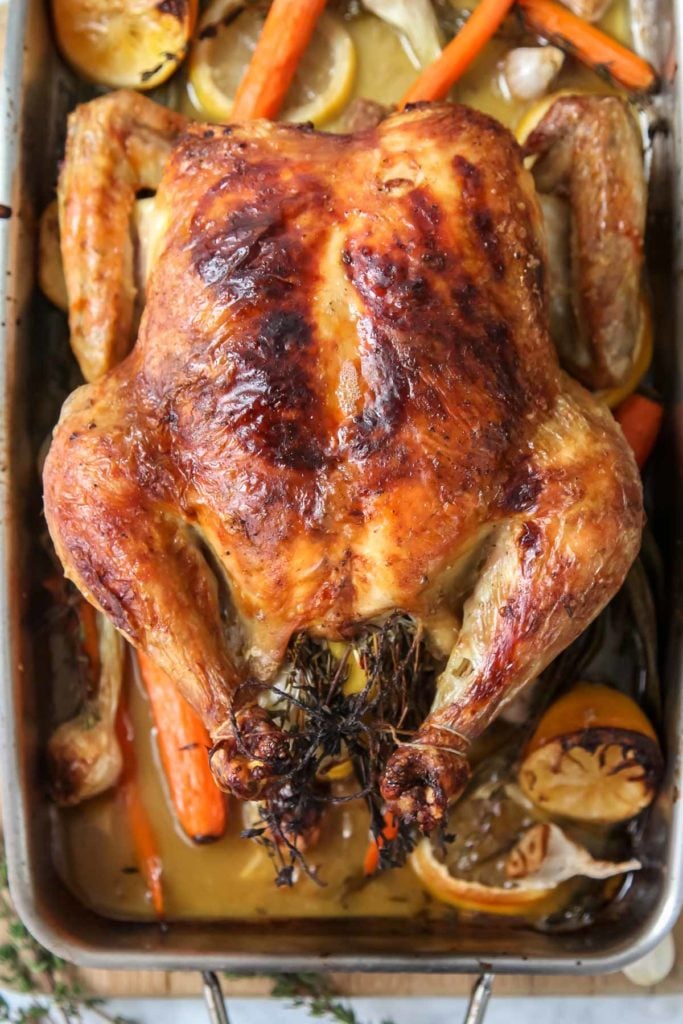A whole roasted chicken is something every home cook should be able to master. This is my foolproof method for an irresistibly flavorful, juicy, crispy roast chicken that’s perfect for meal prep and weeknight dinners.
There’s nothing more comforting than the familiar scent of a chicken roasting away in the oven. The savory aroma of garlic and onion, lemon and herbs, mingling with schmaltzy chicken—it’s a thing of beauty. A roast chicken done right never disappoints. Recipes like my oven-roasted chicken with lemon rosemary garlic butter, 40 cloves of garlic roast chicken, and my cast-iron skillet whole roasted chicken with potatoes, have been longtime favorites, and this simple roast chicken with butter, garlic, lemon, and aromatics is no different (just equally delicious).
A whole roast chicken is something every home cook should be able to master, yet I’ll admit that it took me a while to do so. In the past, I attempted various roast chicken recipes, most of which turned out a bird that was either undercooked or cooked too long with dry, sinewy meat. But after cooking many more chickens since, I figured out the secrets to share with you.
What’s in This Simple Roast Chicken
You don’t need a laundry list of ingredients to make an amazing roast chicken. A few ingredients with big flavor + a foolproof method will do all the heavy lifting in this recipe.
- Whole chicken (4-5 pounds)
- Kosher salt and freshly ground black pepper—If table salt is all you have on hand, use a little less. Iodized salt is more concentrated than kosher salt (also, because it has more iodine, using too much will result in a slightly bitter or metallic flavor).
- Carrots
- Onions
- Garlic
- Lemons
- Butter
- Fresh thyme (you could also use rosemary, tarragon, or parsley)
Or, Keep Things Extra Simple
Sometimes I skip adding some of the aromatics listed above, but I always slather the skin with butter or oil, season with salt and pepper, and roast with garlic and thyme.
PRO TIP: To cook the chicken faster, skip stuffing the bird so the hot air circulates more.
How to Make Roast Chicken
Roasting a whole chicken may seem intimidating but it doesn’t need to be. Here’s my easy step-by-step guide for a perfect roast chicken every time.
Take the chill off. Before prepping the oven-roasted chicken pull your chicken from the refrigerator 30 minutes before roasting to ensure a more even cooking time. Meanwhile, preheat your oven and position a rack in the lower third of the oven. You don’t want the top of your bird burning!
Season generously. Most grocery store rotisserie chickens taste good because the basic chicken meat has been pumped with salt or other brining devices. I’m not a big fan of the Arnold Schwarzenegger “Pump You Up” method, but I do believe in generously seasoning the bird inside and out with a hearty dose of kosher salt and freshly ground black pepper.
Don’t think you have to limit yourself to the seasoning basics. Try different herbs and spices to create flavorful variations to give your clucker a unique flavor, like:
- Chopped fresh or dried oregano, thyme, rosemary, parsley, and tarragon
- Smoked paprika
- Truffle salt
- Coriander
- Garam masala
- Cumin
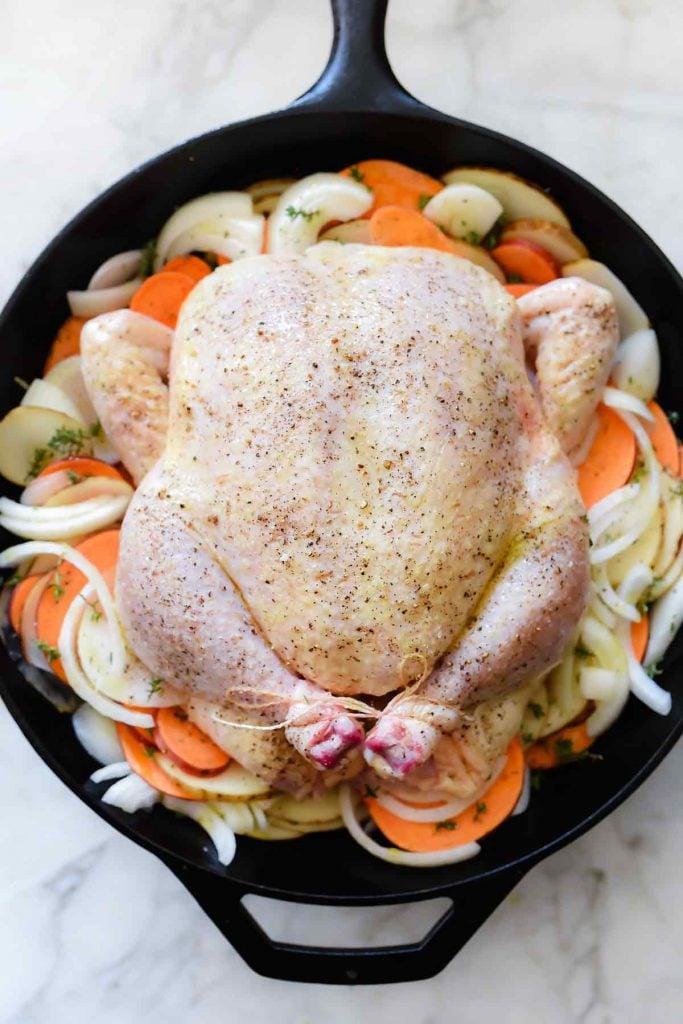
Add Flavor With Fat and Aromatics
Add fat and get under its skin. You know the drill: Fat flavor. To get a crispy skin on your roast chicken that’s juicy on the inside, slather the bird with a butter blend or olive oil. Both work equally well and will turn your bird into a bronzed Brazilian bombshell from the beaches of Rio de Janeiro with a crackin’ crispy crust.
PRO TIP: Try any of these blended butters for maximum flavor.
Gently work your fingers between the skin and the meat of the breasts and legs, separating the two from one another, and work in another layer of flavor with additional butter or oil.
Play with your veggies. Veggies play a two-fold role in this roast chicken recipe. First, stuff your chicken with vegetables and fresh herbs to deliver a lovely flavor from within that permeates every juicy bite of the chicken meat.
Some of my favorite vegetables and aromatics to use are:
- Lemon
- Onion or shallots
- Scallions
- Garlic
- Celery
- Carrots
- Turnips
- Parsnips
- Fresh herbs such as fresh rosemary, tarragon, parsley, thyme
Roast That Bird
Use a low-side roasting pan or rimmed baking sheet. Low sides give hot air more contact with the chicken so it roasts evenly all the way around.
Create a natural roasting surface on the bottom of the roasting pan. Scattered veggies placed under the bird not only keep the skin on the bottom of the bird from sticking to the pan but impart flavor throughout. They also create an amazing base for pan drippings. Use a variety of seasonal veggies to gear the taste to different flavors throughout the year.
Quarter or chop the veggies in large pieces (There’s no need to even peel the skins off.) Add 1 cup of water, chicken broth, or wine to the bottom of the pan if you would like.
Roast Then Rest
Bake and baste. Set the chicken breast-side up on top of the vegetables in the roasting pan. Roast the chicken at 425°F for 45 minutes. Baste with the pan juices and rotate the pan in the oven. Cook for another 30-45 minutes, or when an instant-read thermometer inserted into the inner thigh registers 155° to 160°F and the juices are running clear. Times will vary depending on the weight of the chicken.
Give it a rest. Transfer the bird to a cutting board and tent with foil. Plan on adding an additional 10 minutes of time for the chicken to rest after it’s been cooked. This helps seal in the juices for a tender bite every time. Remove the vegetables from the roasting pan and serve or discard. Serve the chicken hot, or refrigerate for up to 3 days.
Is it Better to Roast Chicken at 350 or 425?
Roast your chicken at 425°F. We’re roasting our chicken, not baking it—that’s why a high temperature will ensure crispy skin that’s juicy on the inside.
PRO TIP: Pull your chicken from the refrigerator 30 minutes before cooking to take the chill off and ensure a more even cooking time.
Do You Cover Chicken While Roasting in Oven?
I don’t recommend covering your chicken unless it begins to brown too much. Direct heat with the chicken is where you’ll get a crisp skin. Covering the chicken will create steam and soften the skin.
How to Tell When a Chicken is Done
Plan on 15-18 minutes of cooking time per pound, then add 15 minutes, plus resting time. For a 5-pound chicken, I plan on 75-90 minutes for a roast chicken to be done. However, the cook time for your specific bird will vary depending on how big it is and how hot your oven burns.
There are 3 ways I use to tell if a chicken is done, and I do each of them every time I roast chicken:
- Use an instant-read thermometer inserted between the breast and thigh meat, avoiding the bone. This is my favorite food thermometer. The temperature of the chicken should read between 155° to 160° F. Allow 10-15 minutes of resting time once you’ve pulled the chicken from the oven so the juices seal into the meat where the chicken will continue to cook as it rests, bringing the temperature up to the recommended 165°F internal temperature.
- Check to see if the juices are running clear. I can usually tell when I pull my thermometer from the meat and the juices run out.
- Wiggle the chicken leg. If it is loose and pliable, the chicken is likely done. As you cook more chickens, you’ll become better at using this method by touch.
